MP4 实际代表的含义是 `MPEG-4 Part 14`。它只是 `MPEG` 标准中的 14 部分。它主要参考 `ISO/IEC` 标准来制定的。MP4 主要作用是可以实现快进快放,边下载边播放的效果。他是基于 `MOV`,然后发展成自己相关的格式内容。然后和 MP4 相关的文件还有:`3GP`,`M4V` 这两种格式。
MP4 的格式稍微比 FLV 复杂一些,它是通过嵌的方式来实现整个数据的携带。换句话说,它的每一段内容,都可以变成一个对象,如果需要播放的话,只要得到相应的对象即可。
MP4 中最基本的单元就是 Box,它内部是通过一个一个独立的 box 拼接而成的。所以,这里,我们先从 Box 的讲解开始。
> PS:作为一个前端开发,在大部分场合了解 MP4 非但没用,而且有点浪费时间。本文推荐阅读是针对音视频开发感兴趣的同学,特别是从事直播,或者,视频播放器业务相关的开发者。
## MP4 box
MP4 box 可以分为 basic box 和 full box。
* basic box: 主要针对的是相关的基础 box。比如 ftyp,moov 等。
* full box: 主要针对视频源的 media box。
这里,再次强调一下,MP4 box 是 MP4 box 的核心。在 decode/encode 过程中,最好把它的基本格式背下来,这样,你写起来会开心很多(经验之谈)。
OK,我们来看一下,Box 的具体结构。
### basic box
首先来看一下 basic box 的结构:
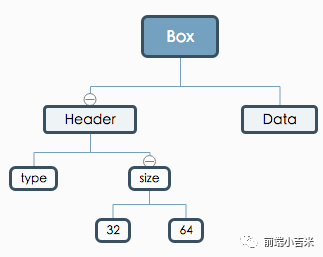
如果用代码来表示就是:
~~~javascript
aligned(8) class Box (unsigned int(32) boxtype, optional unsigned int(8)[16] extended_type) { unsigned int(32) size; unsigned int(32) type = boxtype; if (size==1) { unsigned int(64) largesize;
} else if (size==0) { // box extends to end of file
} // 这里针对的是 MP4 extension 的盒子类型。一般不会发生
if (boxtype==‘uuid’) { unsigned int(8)[16] usertype = extended_type;
}
}
~~~
上面代码其实已经说的很清楚了。这里,我在简单的阐述一下。
* size\[4B\]: 用来代指该 box 的大小,包括 header 和 body。由于其大小有限制,有可能不满足超大的 box。所以,这里有一个判断逻辑,当 `size===1` 时,会出现一个 8B 的 `largesize` 字段来存放大小。当 `size===0` 时,表示文件的结束。
* type\[4B\]: 用来标识该 box 的类型,其实内容很简单,就是直接取指定盒子的英文字母的 ASCII 码。因为 boxname 的长度只有 4 个字母,所以,只需要通过 `charCodeAt` API 获取 4 次即可。
~~~javascript
// 获得指定 box 的 type 字段内容
val.charCodeAt(0)
val.charCodeAt(1)
val.charCodeAt(2)
val.charCodeAt(3)
~~~
实际整个盒子的结构可以用下图来表示:

这里需要强调的一点就是,在 MP4 中,默认写入字节序都是 Big-Endian 。所以,在上面,涉及到 4B 8B 等字段内容时,都是以 BE 来写入的。
上面不是说了,box 有两种基本格式吗?
还有一种为 fullBox
### full box
full box 和 box 的主要区别是增加了 version 和 flag 字段。它的应用场景不高,主要是在 `trak` box 中使用。它的基本格式为:
~~~javascript
aligned(8) class FullBox(unsigned int(32) boxtype, unsigned int(8) v, bit(24) f) extends Box(boxtype) {
unsigned int(8) version = v;
bit(24) flags = f;
}
~~~
在实操中,如果你的没有针对 version 和 flags 的业务场景,那么基本上就可以直接设为默认值,比如 0x00。它的基本结构图为:

在实际 remux 中,会以 `box` 为最小组合单位,来完成相关的 remux 过程。比如,这里以 JS 来完成最小基本 box 的构造:
~~~javascript
MP4.box = function (type) {
let boxLength = 8; // include the total 8 byte length of size and type
let buffers = Array.prototype.slice.call(arguments, 1);
buffers.forEach(val => { boxLength += val.byteLength; });
let boxBuffer = new Uint8Array(boxLength); // the first four byte stands for boxLength boxBuffer[0] = (boxLength >> 24) & 0xff;
boxBuffer[1] = (boxLength >> 16) & 0xff;
boxBuffer[2] = (boxLength >> 8) & 0xff;
boxBuffer[3] = boxLength & 0xff;
// the second four byte is box's type boxBuffer.set(type, 4);
let offset = 8; // the byteLength of type and size
buffers.forEach(val => { boxBuffer.set(val, offset);
offset += val.byteLength; })
return boxBuffer;}
~~~
上述,通常的调用方法为:
~~~javascript
// MP4.symbolValue.FTYP 为某一个具体的 BufferMP4.box(MP4.types.ftyp, MP4.symbolValue.FTYP);
~~~
接下来,我们就要正式的来看一下,MP4 中真正用到的一些 Box 了。
这里,我们按照 MP4 box 的划分来进行相关的阐述。先看一张 MP4 给出的结构图:
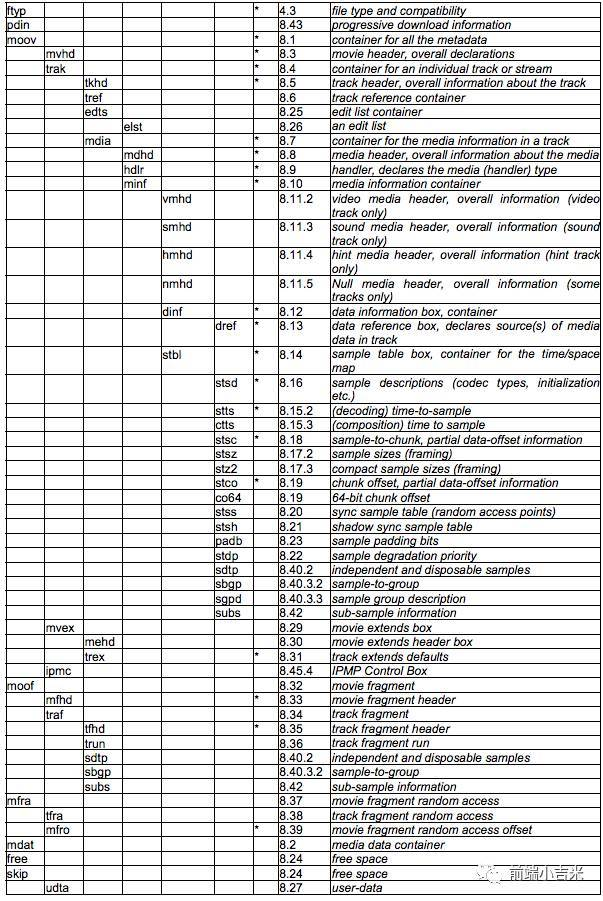
说明一下,我们只讲带星号的 box。其他的因为不是必须 box,我们就选择性的忽略了。不过,里面带星号的 Box 还是挺多的。因为,我们的主要目的是为了生成一个 MP4 文件。一个正常的 MP4 文件的结构并不是所有带星号的 Box 都必须有。
正常播放的 MP4 文件其实还可以分为 unfragmented MP4(简写为 MP4) 和 fragmented MP4(简写为 FMP4)。那这两者具体有什么区别呢?
可以说,完全不同。因为他们本身确定 media stream 播放的方式都是完全不同的模式。
.
**MP4 格式**
基本 box 为:
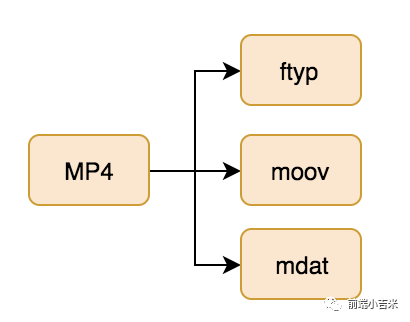
上面这是最基本的 MP4 Box 内容。 较完整的为:
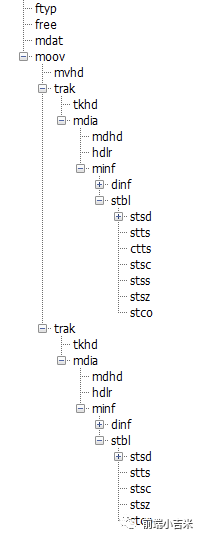
MP4 box 根据 trak 中的 stbl 下的 stts stsc 等基本 box 来完成在 mdat box 中的索引。那 FMP4 是啥呢?
* 非标:非标常用于生成单一 trak 的文件。
* ftyp
* moov
* moof
* mdat
* 标准:用来生成含有多个 trak 的文件。
* ftyp
* moov
* mdat
看起来非标还多一个 box。但在具体编解码的时候,标准解码需要更多关注在如何编码 stbl 下的几个子 box--stts,stco,ctts 等盒子。而非标不需要关注 stbl,只需要将本来处于 stbl 的数据直接抽到 moof 中。并且在转换过程中,moof 里面的格式相比 stbl 来说,是非常简单的。所以,这里,我们主要围绕上面两种的标准,来讲解对应的 Box。
## 标准 MP4 盒子
### ftyp
ftyp 盒子相当于就是该 mp4 的纲领性说明。即,告诉解码器它的基本解码版本,兼容格式。简而言之,就是用来告诉客户端,该 MP4 的使用的解码标准。通常,ftyp 都是放在 MP4 的开头。
它的格式为:
~~~javascript
aligned(8) class FileTypeBox extends Box(‘ftyp’) { unsigned int(32) major_brand; unsigned int(32) minor_version; unsigned int(32) compatible_brands[];
}
~~~
上面的字段一律都是放在 `data` 字段中(参考,box 的描述)。
* major\_brand: 因为兼容性一般可以分为推荐兼容性和默认兼容性。这里 major\_brand 就相当于是推荐兼容性。通常,在 Web 中解码,一般而言都是使用 `isom` 这个万金油即可。如果是需要特定的格式,可以自行定义。
* minor\_version: 指最低兼容版本。
* compatible\_brands: 和 major\_brand 类似,通常是针对 MP4 中包含的额外格式,比如,AVC,AAC 等相当于的音视频解码格式。
说这么多概念,还不如给代码实在。这里,我们可以来看一下,对于通用 ftyp box 的创建。
~~~javascript
FTYP: new Uint8Array([ 0x69, 0x73, 0x6F, 0x6D, // major_brand: isom
0x0, 0x0, 0x0, 0x1, // minor_version: 0x01
0x69, 0x73, 0x6F, 0x6D, // isom
0x61, 0x76, 0x63, 0x31 // avc1
])
~~~
### moov
moov box 主要是作为一个很重要的容器盒子存在的,它本身的实际内容并不重要。moov 主要是存放相关的 trak 。其基本格式为:
~~~javascript
aligned(8) class MovieExtendsBox extends Box(‘mvex’){ }
~~~
### mvhd
mvhd 是 moov 下的第一个 box,用来描述 media 的相关信息。其基本内容为:
~~~javascript
aligned(8) class MovieHeaderBox extends FullBox(‘mvhd’, version, 0) {
if (version==1) {
unsigned int(64) creation_time;
unsigned int(64) modification_time;
unsigned int(32) timescale;
unsigned int(64) duration;
} else { // version==0
unsigned int(32) creation_time;
unsigned int(32) modification_time;
unsigned int(32) timescale;
unsigned int(32) duration;
}
template int(32) rate = 0x00010000; // typically 1.0template int(16) volume = 0x0100; // typically, full volumeconst bit(16) reserved = 0;
const unsigned int(32)[2] reserved = 0;
template int(32)[9] matrix =
{ 0x00010000,0,0,0,0x00010000,0,0,0,0x40000000 }; // Unity matrix
bit(32)[6] pre_defined = 0;
unsigned int(32) next_track_ID;
}
~~~
* version: 一般默认为 0。
* creation\_time: 创建的时间。从 1904 年开始算起,用秒来表示。
* timescale: 时间比例。通过该值和 duration 来算出实际时间
* duration: 持续时间,单位是根据 timescale 来决定的。实际时间为:duration/timescale = xx 秒。
* rate: 播放比例。
* volume: 音量大小。0x0100 为最大值。
* matrix: 不解释。我也不懂
* next\_track\_ID: 需要比当前 trak\_id 最大值还大才行。一般随便填个很大的值即可。
实际上,mvhd 大部分的值,都可以设为固定值:
~~~javascript
new Uint8Array([ 0x00, 0x00, 0x00, 0x00, // version(0) + flags
0x00, 0x00, 0x00, 0x00, // creation_time
0x00, 0x00, 0x00, 0x00, // modification_time
(timescale >>> 24) & 0xFF, // timescale: 4 bytes
(timescale >>> 16) & 0xFF,
(timescale >>> 8) & 0xFF,
(timescale) & 0xFF,
(duration >>> 24) & 0xFF, // duration: 4 bytes
(duration >>> 16) & 0xFF,
(duration >>> 8) & 0xFF,
(duration) & 0xFF, 0x00, 0x01, 0x00, 0x00, // Preferred rate: 1.0
0x01, 0x00, 0x00, 0x00, // PreferredVolume(1.0, 2bytes) + reserved(2bytes)
0x00, 0x00, 0x00, 0x00, // reserved: 4 + 4 bytes
0x00, 0x00, 0x00, 0x00, 0x00, 0x01, 0x00, 0x00, // ----begin composition matrix----
0x00, 0x00, 0x00, 0x00, 0x00, 0x00, 0x00, 0x00, 0x00, 0x00, 0x00, 0x00, 0x00, 0x01, 0x00, 0x00, 0x00, 0x00, 0x00, 0x00, 0x00, 0x00, 0x00, 0x00, 0x00, 0x00, 0x00, 0x00, 0x40, 0x00, 0x00, 0x00, // ----end composition matrix----
0x00, 0x00, 0x00, 0x00, // ----begin pre_defined 6 * 4 bytes----
0x00, 0x00, 0x00, 0x00, 0x00, 0x00, 0x00, 0x00, 0x00, 0x00, 0x00, 0x00, 0x00, 0x00, 0x00, 0x00, 0x00, 0x00, 0x00, 0x00, // ----end pre_defined 6 * 4 bytes----
0xFF, 0xFF, 0xFF, 0xFF // next_track_ID
]);
~~~
*****
## trak
trak box 就是主要存放相关 media stream 的内容。其基本格式很简单就是简单的 box:
~~~javascript
aligned(8) class TrackBox extends Box(‘trak’) { }
~~~
不过,有时候里面也可以带上该 media stream 的相关描述:
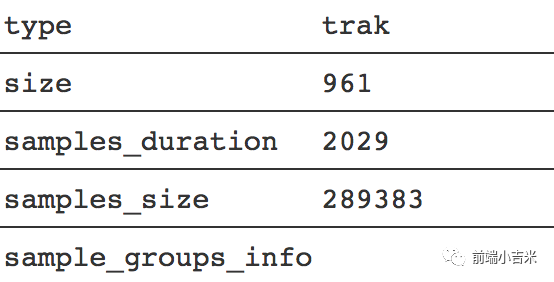
### tkhd
tkhd 是 trak box 的子一级 box 的内容。主要是用来描述该特定 trak 的相关内容信息。其主要内容为:
~~~javascript
aligned(8) class TrackHeaderBox
extends FullBox(‘tkhd’, version, flags){ if (version==1) { unsigned int(64) creation_time; unsigned int(64) modification_time; unsigned int(32) track_ID; const unsigned int(32) reserved = 0; unsigned int(64) duration;
} else { // version==0
unsigned int(32) creation_time; unsigned int(32) modification_time; unsigned int(32) track_ID; const unsigned int(32) reserved = 0; unsigned int(32) duration;
}const unsigned int(32)[2] reserved = 0;template int(16) layer = 0;template int(16) alternate_group = 0;template int(16) volume = {if track_is_audio 0x0100 else 0};
const unsigned int(16) reserved = 0;template int(32)[9] matrix=
{ 0x00010000,0,0,0,0x00010000,0,0,0,0x40000000 }; // unity matrix
unsigned int(32) width; unsigned int(32) height;
}
~~~
上面内容确实挺多的,但是,有些并不是一定需要填一些合法值。这里简单说明一下:
* creation\_time: 创建时间,非必须
* modification\_time: 修改时间,非必须
* track\_ID: 指明当前描述的 track ID。
* duration: 当前 track 内容持续的时间。通常结合 timescale 进行相关计算。
* layer: 没啥用。通常用来作为分成 video trak 的使用。
* alternate\_group: 可替换 track 源。如果为 0 表示当前 track 没有指定的 track 源替代。非 0 的话,则表示存在多个源的 group。
* volume: 用来确定音量大小。满音量为 1(0x0100)。
* width and height:确定视频的宽高
### mdia
mdia 主要用来包裹相关的 media 信息。本身没啥说的,格式为:
~~~javascript
aligned(8) class MediaBox extends Box(‘mdia’) { }
~~~
### mdhd
mdhd 和 tkhd 来说,内容大致都是一样的。不过,tkhd 通常是对指定的 track 设定相关属性和内容。而 mdhd 是针对于独立的 media 来设置的。不过事实上,两者一般都是一样的。
具体格式为:
~~~javascript
aligned(8) class MediaHeaderBox extends FullBox(‘mdhd’, version, 0) { if (version==1) { unsigned int(64) creation_time; unsigned int(64) modification_time; unsigned int(32) timescale; unsigned int(64) duration;
} else { // version==0
unsigned int(32) creation_time; unsigned int(32) modification_time; unsigned int(32) timescale; unsigned int(32) duration;
}bit(1) pad = 0;unsigned int(5)[3] language; // ISO-639-2/T language code unsigned int(16) pre_defined = 0;}
~~~
里面就有 3 个额外的字段:pad,language,pre\_defined。
根据字面意思很好理解:
* pad: 占位符,通常为 0
* language: 表明当前 trak 的语言。因为该字段总长为 15bit,通常是和 pad 组合成为 2B 的长度。
* pre\_defined: 默认为 0.
实际代码的计算方式为:
~~~javascript
new Uint8Array([ 0x00, 0x00, 0x00, 0x00, // version(0) + flags
0x00, 0x00, 0x00, 0x00, // creation_time
0x00, 0x00, 0x00, 0x00, // modification_time
(timescale >>> 24) & 0xFF, // timescale: 4 bytes
(timescale >>> 16) & 0xFF,
(timescale >>> 8) & 0xFF,
(timescale) & 0xFF,
(duration >>> 24) & 0xFF, // duration: 4 bytes
(duration >>> 16) & 0xFF,
(duration >>> 8) & 0xFF,
(duration) & 0xFF, 0x55, 0xC4, // language: und (undetermined)
0x00, 0x00 // pre_defined = 0
])
~~~
### hdlr
hdlr 是用来设置不同 trak 的处理方式的。常用处理方式如下:
* vide : Video track
* soun : Audio track
* hint : Hint track
* meta : Timed Metadata track
* auxv : Auxiliary Video track
这个,其实就和我们在得到和接收到资源时,设置的 `Content-Type` 类型字段是一致的,例如 `application/javascript`。
其基本格式为:
~~~javascript
aligned(8) class HandlerBox extends FullBox(‘hdlr’, version = 0, 0) {
unsigned int(32) pre_defined = 0;
unsigned int(32) handler_type;
const unsigned int(32)[3] reserved = 0;
string name;
}
~~~
其中有两字段需要额外说明一下:
* handler\_type:是代指具体 trak 的处理类型。也就是我们上面列写的 vide,soun,hint 字段。
* name: 是用来写名字的。其主要不是给机器读的,而是给人读,所以,这里你只要觉得能表述清楚,填啥其实都行。
handler\_type 填的值其实就是 string 转换为 hex 之后得到的值。比如:
* vide 为 `0x76, 0x69, 0x64, 0x65`
* soun 为 `0x73, 0x6F, 0x75, 0x6E`
### minf
minf 是子属内容中,重要的容器 box,用来存放当前 track 的基本描述信息。本身没啥说的,基本格式为:
~~~javascript
aligned(8) class MediaInformationBox extends Box(‘minf’) { }
~~~
### v/smhd
v/smhd 是对当前 trak 的描述 box。vmhd 针对的是 video,smhd 针对的是 audio。这两个盒子在解码中,非不可或缺的(有时候得看播放器),缺了的话,有可能会被认为格式不正确。
我们先来看一下 vmhd 的基本格式:
~~~javascript
aligned(8) class VideoMediaHeaderBox
extends FullBox(‘vmhd’, version = 0, 1) {
template unsigned int(16) graphicsmode = 0; // copy, see below template unsigned int(16)[3] opcolor = {0, 0, 0};
}
~~~
这很简单都是一些默认值,我这里就不多说了。
smhd 的格式同样也很简单:
~~~javascript
aligned(8) class SoundMediaHeaderBox
extends FullBox(‘smhd’, version = 0, 0) { template int(16) balance = 0; const unsigned int(16) reserved = 0;
}
~~~
其中,balance 这个字段相当于和我们通常设置的左声道,右声道有关。
* balance: 该值是一个浮点值,0 为 center,1.0 为 right,-1.0 为 left。
### dinf
dinf 是用来说明在 trak 中,media 描述信息的位置。其实本身就是一个容器,没啥内容:
~~~javascript
aligned(8) class DataInformationBox extends Box(‘dinf’) { }
~~~
### dref
dref 是用来设置当前 Box 描述信息的 data\_entry。基本格式为:
~~~javascript
aligned(8) class DataReferenceBox
extends FullBox(‘dref’, version = 0, 0) {
unsigned int(32) entry_count; for (i=1; i <= entry_count; i++) {
DataEntryBox(entry_version, entry_flags) data_entry; }
}
~~~
其中的 DataEntryBox 就是 DataEntryUrlBox/DataEntryUrnBox 中的一个。简单来说,就是 dref 下的子 box -- `url` 或者 `urn` 这两个 box。其中,entry\_version 和 entry\_flags 需要额外说明一下。
* entry\_version: 用来指明当前 entry 的格式
* entry\_flags: 其值不是固定的,但是有一个特殊的值, 0x000001 用来表示当前 media 的数据和 moov 包含的数据一致。
不过,就通常来说,我真的没有用到过有实际数据的 dref 。所以,这里就不衍生来讲了。
### url
url box 是由 dref 包裹的子一级 box,里面是对不同的 sample 的描述信息。不过,一般都是附带在其它 box 里。其基本格式为:
~~~javascript
aligned(8) class DataEntryUrlBox (bit(24) flags) extends FullBox(‘url ’, version = 0, flags) {
string location;
}
~~~
实际并没有用到过 `location` 这个字段,所以,一般也就不需要了。
### stts
stts 主要是用来存储 refSampleDelta。即,相邻两帧间隔的时间。它基本格式为:
~~~javascript
aligned(8) class TimeToSampleBox
extends FullBox(’stts’, version = 0, 0) { unsigned int(32) entry_count; int i; for (i=0; i < entry_count; i++) { unsigned int(32) sample_count; unsigned int(32) sample_delta;
}
}
~~~
看代码其实看不出什么,我们结合实际抓包结果,来讲解。现有如下的帧:

可以看到,上面的 Decode delta 值都是 10。这就对应着 sample\_delta 的值。而 sample\_count 就对应出现几次的 sample\_delta。比如,上面 10 的 delta 出现了 14 次,那么 sample\_count 就是 14。
如果对应于 RTMP 中的 Video Msg,那么 sample\_delta 就是当前 RTMP Header 中,后面一个的 timeStamp delta。
### stco
stco 是 stbl 包里面一个非常关键的 Box。它用来定义每一个 sample 在 mdat 具体的位置。基本格式为:
~~~javascript
aligned(8) class ChunkOffsetBox
extends FullBox(‘stco’, version = 0, 0) {
unsigned int(32) entry_count;for (i=1; i u entry_count; i++) { unsigned int(32) chunk_offset;
}
}
~~~
具体可以参考:

stco 有两种形式,如果你的视频过大的话,就有可能造成 chunkoffset 超过 32bit 的限制。所以,这里针对大 Video 额外创建了一个 co64 的 Box。它的功效等价于 stco,也是用来表示 sample 在 `mdat` box 中的位置。只是,里面 chunk\_offset 是 64bit 的。
~~~javascript
aligned(8) class ChunkLargeOffsetBox extends FullBox(‘co64’, version = 0, 0) {
unsigned int(32) entry_count;for (i=1; i u entry_count; i++) {
unsigned int(64) chunk_offset;
}
}
~~~
### stsc
stsc 这个 Box 有点绕,并不是它的字段多,而是它的字段意思有点奇怪。其基本格式为:
~~~javascript
aligned(8) class SampleToChunkBox
extends FullBox(‘stsc’, version = 0, 0) {
unsigned int(32) entry_count; for (i=1; i u entry_count; i++) { unsigned int(32) first_chunk; unsigned int(32) samples_per_chunk;
unsigned int(32) sample_description_index;
}
}
~~~
关键点在于他们里面的三个字段: `first_chunk`,`samples_per_chunk`,`sample_description_index`。
* first\_chunk: 每一个 entry 开始的 chunk 位置。
* samples\_per\_chunk: 每一个 chunk 里面包含多少的 sample
* sample\_description\_index: 每一个 sample 的描述。一般可以默认设置为 1。
这 3 个字段实际上决定了一个 MP4 中有多少个 chunks,每个 chunks 有多少个 samples。这里顺便普及一下 chunk 和 sample 的相关概念。在 MP4 文件中,最小的基本单位是 `Chunk` 而不是 `Sample`。
* sample: 包含最小单元数据的 slice。里面有实际的 NAL 数据。
* chunk: 里面包含的是一个一个的 sample。为了是优化数据的读取,让 I/O 更有效率。
看了上面字段就懂得,感觉你要么是大牛,要么就是在装逼。官方文档和上面一样的描述,但是,看了一遍后,懵逼,再看一遍后,懵逼。所以,这里为了大家更好的理解,这里额外再补充一下。
前面说了,在 MP4 中最小的单位是 chunks,那么通过 stco 中定义的 chunk\_offsets 字段,它描述的就是 chunks 在 mdat 中的位置。每一个 stco chunk\_offset 就对应于 某一个 index 的 chunks。那么,`first_chunk` 就是用来定义该 chunk entry 开始的位置。
那这样的话,stsc 需要对每一个 chunk 进行定义吗?
不需要,因为 stsc 是定义一整个 entry,即,如果他们的 `samples_per_chunk`,`sample_description_index` 不变的话,那么后续的 chunks 都是用一样的模式。
即,如果你的 stsc 只有:
* first\_chunk: 1
* samples\_per\_chunk: 4
* sample\_description\_index: 1
也就是说,从第一个 chunk 开始,每通过切分 4 个 sample 划分为一个 chunk,并且每个 sample 的表述信息都是 1。它会按照这样划分方法一直持续到最后。当然,如果你的 sample 最后不能被 4 整除,最后的几段 sample 就会当做特例进行处理。
通常情况下,stsc 的值是不一样的:

按照上面的情况就是,第 1 个 chunk 包含 2 个 samples。第 2-4 个 chunk 包含 1 个 sample,第 5 个 chunk 包含两个 chunk,第 6 个到最后一个 chunk 包含一个 sample。
### ctts
ctts 主要针对 Video 中的 B 帧来确定的。也就是说,如果你视频里面没有 B 帧,那么,ctts 的结构就很简单了。它主要的作用,是用来记录每一个 sample 里面的 cts。格式为:
~~~javascript
aligned(8) class CompositionOffsetBox extends FullBox(‘ctts’, version = 0, 0) {
unsigned int(32) entry_count;
int i; for (i=0; i < entry_count; i++) {
unsigned int(32) sample_count;
unsigned int(32) sample_offset;
}
}
~~~
还是看实例吧,假如你视频中帧的排列如下:

其中,sample\_offset 就是 Composition offset。通过合并一致的 Composition offset,可以得到对应的 sample\_count。最终 ctts 的结果为:
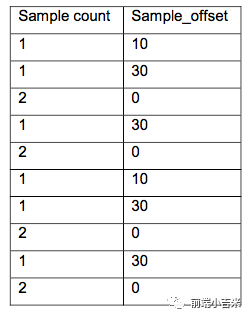
看实例抓包的结果为:
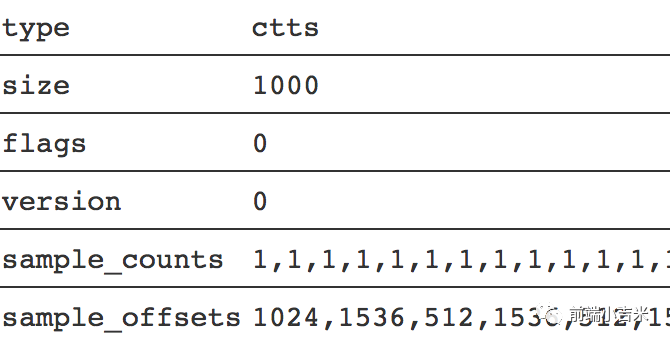
如果,你是针对 RTMP 的 video,由于,其没有 B 帧,那么 ctts 的整个结果,就只有一个 sample\_count 和 sample\_offset。比如:
~~~javascript
sample_count: 100sample_offset: 0
~~~
通常只有 video track 才需要 ctts。
### stsz
stsz 是用来存放每一个 sample 的 size 信息的。基本格式为:
~~~javascript
aligned(8) class SampleSizeBox extends FullBox(‘stsz’, version = 0, 0) {
unsigned int(32) sample_size;
unsigned int(32) sample_count;if (sample_size==0) { for (i=1; i <= sample_count; i++) {
unsigned int(32) entry_size;
}
}
}
~~~
这个没啥说的,就是所有 sample 的 size 大小,以及相应的描述信息。
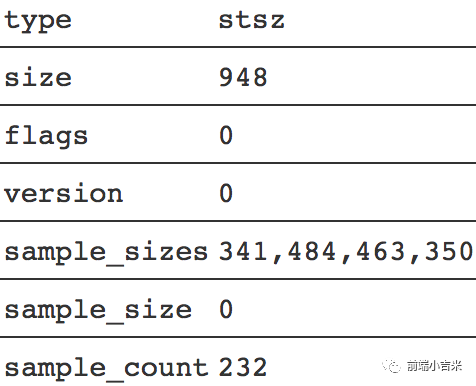
## fragmented MP4
前面部分是标准 box 的所有内容。当然,fMP4 里面大部分内容和 MP4 标准格式有很多重复的地方,剩下的就不过多赘述,只把不同的单独挑出来讲解。
### mvex
mvex 是 fMP4 的标准盒子。它的作用是告诉解码器这是一个 fMP4 的文件,具体的 samples 信息内容不再放到 trak 里面,而是在每一个 moof 中。基本格式为:
~~~javascript
aligned(8) class MovieExtendsBox extends Box(‘mvex’){ }
~~~
### trex
trex 是 mvex 的子一级 box 用来给 fMP4 的 sample 设置默认值。基本内容为:
~~~javascript
aligned(8) class TrackExtendsBox extends FullBox(‘trex’, 0, 0){
unsigned int(32) track_ID;
unsigned int(32) default_sample_description_index;
unsigned int(32) default_sample_duration;
unsigned int(32) default_sample_size;
unsigned int(32) default_sample_flags
}
~~~
具体设哪一个值,这得看你业务里面具体的要求才行。 如果实在不知道,那就可以直接设置为 0:
~~~javascript
new Uint8Array([ 0x00, 0x00, 0x00, 0x00, // version(0) + flags
(trackId >>> 24) & 0xFF, // track_ID
(trackId >>> 16) & 0xFF,
(trackId >>> 8) & 0xFF,
(trackId) & 0xFF, 0x00, 0x00, 0x00, 0x01, // default_sample_description_index
0x00, 0x00, 0x00, 0x00, // default_sample_duration
0x00, 0x00, 0x00, 0x00, // default_sample_size
0x00, 0x01, 0x00, 0x01 // default_sample_flags
])
~~~
### moof
moof 主要是用来存放 FMP4 的相关内容。它本身没啥太多的内容:
~~~javascript
aligned(8) class TrackFragmentBox extends Box(‘traf’){
}
~~~
### tfhd
tfhd 主要是对指定的 trak 进行相关的默认设置。例如:sample 的时长,大小,偏移量等。不过,这些都可以忽略不设,只要你在其它 box 里面设置完整即可:
~~~javascript
aligned(8) class TrackFragmentHeaderBox extends FullBox(‘tfhd’, 0, tf_flags){ unsigned int(32) track_ID;// all the following are optional fields
unsigned int(64) base_data_offset; unsigned int(32) sample_description_index; unsigned int(32) default_sample_duration; unsigned int(32) default_sample_size; unsigned int(32) default_sample_flags
}
~~~
base\_data\_offset 是用来计算后面数据偏移量用到的。如果存在则会用上,否则直接是相关开头的偏移。
### tfdt
tfdt 主要是用来存放相关 sample 编码的绝对时间的。因为 FMP4 是流式的格式,所以,不像 MP4 一样可以直接根据 sample 直接 seek 到具体位置。这里就需要一个标准时间参考,来快速定位都某个具体的 fragment。
它的基本格式为:
~~~javascript
aligned(8) class TrackFragmentBaseMediaDecodeTimeBox extends FullBox(‘tfdt’, version, 0) {if (version==1) {
unsigned int(64) baseMediaDecodeTime;
} else { // version==0
unsigned int(32) baseMediaDecodeTime;
}
}
~~~
baseMediaDecodeTime 基本值是前面所有指定 trak\_id 中 samples 持续时长的总和,相当于就是当前 traf 里面第一个 sample 的 dts 值。
### trun
trun 存储该 moof 里面相关的 sample 内容。例如,每个 sample 的 size,duration,offset 等。基本内容为:
~~~javascript
aligned(8) class TrackRunBox extends FullBox(‘trun’, version, tr_flags) {unsigned int(32) sample_count;// the following are optional fieldssigned int(32) data_offset;unsigned int(32) first_sample_flags;// all fields in the following array are optional {
unsigned int(32) sample_duration; unsigned int(32) sample_size; unsigned int(32) sample_flags if (version == 0)
{ unsigned int(32) sample_composition_time_offset else
{ signed int(32) sample_composition_time_offset
}[ sample_count ]
}
~~~
可以说,trun 上面的字段是 traf 里面最重要的标识字段:
tr\_flags 是用来表示下列 sample 相关的标识符是否应用到每个字段中:
* 0x000001: data-offset-present,只应用 data-offset
* 0x000004: 只对第一个 sample 应用对应的 flags。剩余 sample flags 就不管了。
* 0x000100: 这个比较重要,表示每个 sample 都有自己的 duration,否则使用默认的
* 0x000200: 每个 sample 有自己的 sample\_size,否则使用默认的。
* 0x000400: 对每个 sample 使用自己的 flags。否则,使用默认的。
* 0x000800: 每个 sample 都有自己的 cts 值
后面字段,我们这简单介绍一下。
* data\_offset: 用来表示和该 moof 配套的 mdat 中实际数据内容距 moof 开头有多少 byte。相当于就是 moof.byteLength + mdat.headerSize。
* sample\_count: 一共有多少个 sample
* first\_sample\_flags: 主要针对第一个 sample。一般来说,都可以默认设为 0。
后面的几个字段,我就不赘述了,对了,里面的 sample\_flags 是一个非常重要的东西,常常用它来表示,到底哪一个 sampel 是对应的 keyFrame。基本计算方法为:
~~~javascript
(flags.isLeading << 2) | flags.dependsOn, // sample_flags(flags.isDepended << 6) | (flags.hasRedundancy << 4) | flags.isNonSync
~~~
### sdtp
sdtp 主要是用来描述具体某个 sample 是否是 I 帧,是否是 leading frame 等相关属性值,主要用来作为当进行点播回放时的同步参考信息。其内容一共有 4 个:
* is\_leading:是否是开头部分。
* 0: 当前 sample 的 leading 属性未知(经常用到)
* 1: 当前 sample 是 leading sample,并且不能被 decoded
* 2: 当前 sample 并不是 leading sample。
* 3: 当前 sample 是 leading sample,并且能被 decoded
* sample\_depends\_on:是否是 I 帧。
* 0: 该 sample 不知道是否依赖其他帧
* 1: 该 sample 是 B/P 帧
* 2: 该 sample 是 I 帧。
* 3: 保留字
* sample\_is\_depended\_on: 该帧是否被依赖
* 0: 不知道是否被依赖,特指(B/P)
* 1: 被依赖,特指 I 帧
* 3: 保留字
* sample\_has\_redundancy: 是否有冗余编码
* 0: 不知道是否有冗余
* 1: 有冗余编码
* 2: 没有冗余编码
* 3: 保留字
整个基本格式为:
~~~javascript
aligned(8) class SampleDependencyTypeBox extends FullBox(‘sdtp’, version = 0, 0) {
for (i=0; i < sample_count; i++){
unsigned int(2) is_leading;
unsigned int(2) sample_depends_on;
unsigned int(2) sample_is_depended_on;
unsigned int(2) sample_has_redundancy;
}
}
~~~
sdtp 对于 video 来说很重要,因为,其内容字段主要就是给 video 相关的帧设计的。而 audio,一般直接采用默认值:
~~~javascript
isLeading: 0,dependsOn: 1,
isDepended: 0,hasRedundancy: 0
~~~
到这里,整个 MP4 和 fMP4 的内容就已经介绍完了。更详细的内容可以参考 MP4 & FMP4 doc。
当然,这里只是非常皮毛的一部分,仅仅知道 box 的内容,并不足够来做一些音视频处理。更多的是关于音视频的基础知识,比如,dts/pts、音视频同步、视频盒子的封装等等
- 序言
- 编解码
- H264
- HEVC码流解析
- H264编码原理
- 多媒体封装
- MP4
- 学好 MP4,让直播更给力
- AAC
- FLV
- 流媒体协议
- RTSP
- RTCP
- RTP
- H265 RTP封包笔记
- SDP
- RTMP
- RTMP URL
- rtmp url基础
- webrtc
- 编译
- 最简单的编译webrtc方案
- Webrtc音视频会议之Webrtc“不求甚解”
- Webrtc音视频会议之Mesh/MCU/SFU三种架构
- 音频传输之Jitter Buffer设计与实现
- Janus
- Webrtc音视频会议之Janus编译
- Webrtc音视频会议之Janus源码架构设计
- webrtc服务器-janus房间管理
- 源码分析
- WebRTC视频JitterBuffer详解
- 走读Webrtc 中的视频JitterBuffer(一)
- 走读webrtc 中的视频JitterBuffer(二)
- webrtc视频帧率控制算法机制
- 目标码率丢帧-1
- 目标帧率丢帧-2
- 29 如何使用Medooze 实现多方视频会议
- FFmpeg
- FFmpeg编译
- Window10下编译最新版FFmpeg的方法步骤
- FFMPEG静态库编译
- ffmpeg实现画中画
- FFmpeg推流器
- ffmpeg-aac
- OpenCV
- OpenCV学习笔记——视频的边缘检测
- 图像特征点匹配(视频质量诊断、画面抖动检测)
- 图像质量诊断
